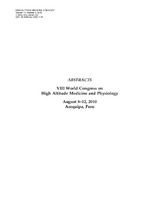Mostrar el registro sencillo del ítem
Hematocrit and hemoglobin levels at adulthood are determined by neonatal hypoxic exposure in rats living at high altitude
| dc.contributor.author | Lumbroso, Delphine | |
| dc.contributor.author | Villalpando, Gabriela | |
| dc.contributor.author | Gonzales, Marcelino | |
| dc.contributor.author | Soria Sánchez, Rudy | |
| dc.contributor.author | Joseph, Vincent | |
| dc.date.accessioned | 2016-09-30T18:05:54Z | |
| dc.date.available | 2016-09-30T18:05:54Z | |
| dc.date.issued | 2010-08-08 | |
| dc.identifier.uri | http://repositorio.umsa.bo/xmlui/handle/123456789/8113 | |
| dc.description.abstract | Introduction: In previous work performed at sea level we reported that exposure to neonatal hypoxia impairs ventilatory and hematological responses to chronic hypoxia later in life. These findings supported the hypothesis that neonatal hypoxia might be a critical factor in the development of chronic mountain sickness, which mainly occurs in men at high altitude, and is characterized by hypoventilation and excessive erythocytosis. In the present work we tested the hypothesis that hypoxia during early life has long-lasting impacts on the hematological acclimation in adult rats permanently living at high altitude... | es_ES |
| dc.language.iso | en | es_ES |
| dc.publisher | High Altitude Medicine & Biology | es_ES |
| dc.subject | HEMATOCRITO Y HEMOGLOBINA | es_ES |
| dc.subject | HIPOXIA NEONATAL | es_ES |
| dc.subject | RATAS | es_ES |
| dc.subject | ALTURA | es_ES |
| dc.title | Hematocrit and hemoglobin levels at adulthood are determined by neonatal hypoxic exposure in rats living at high altitude | es_ES |
| dc.type | Article | es_ES |

